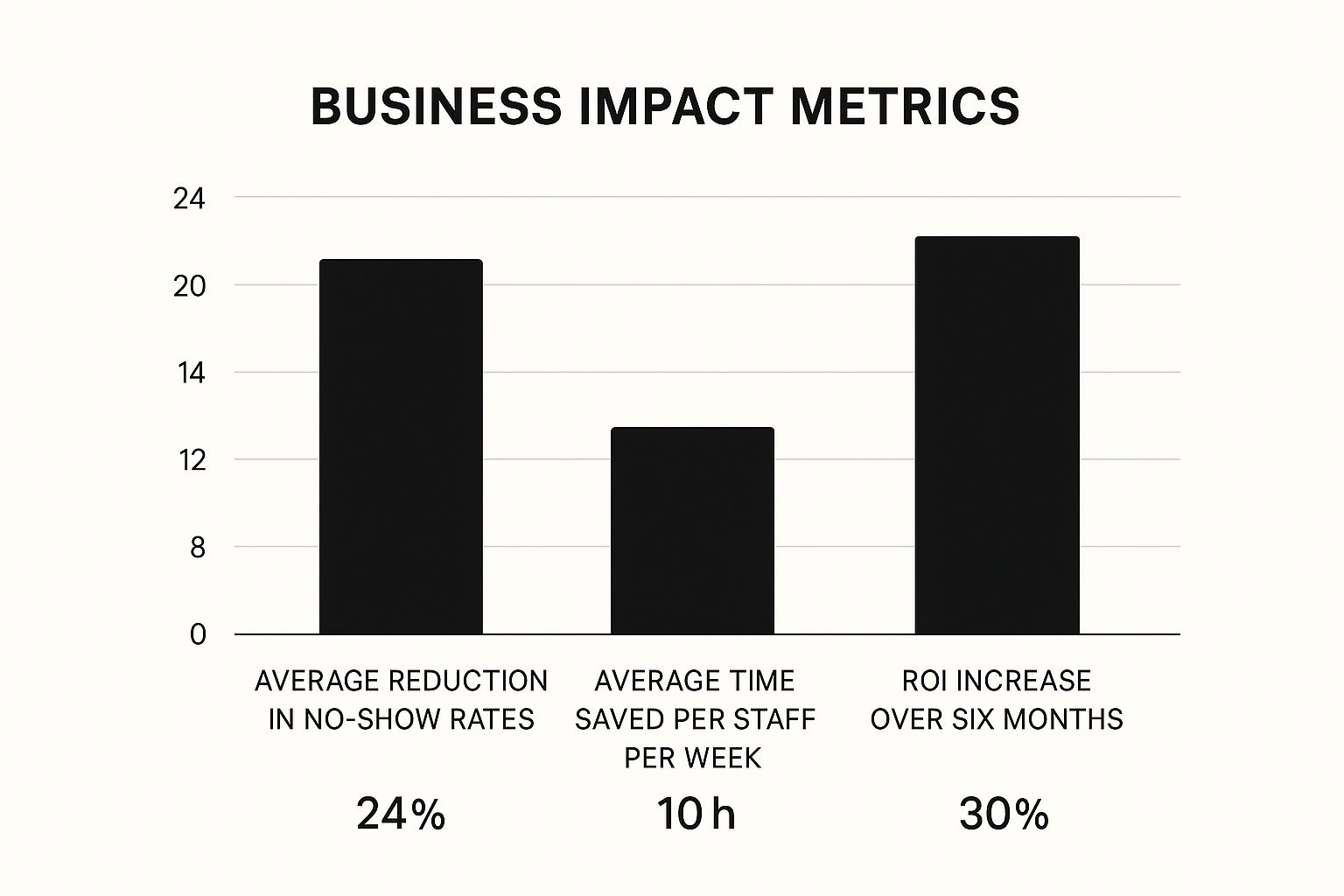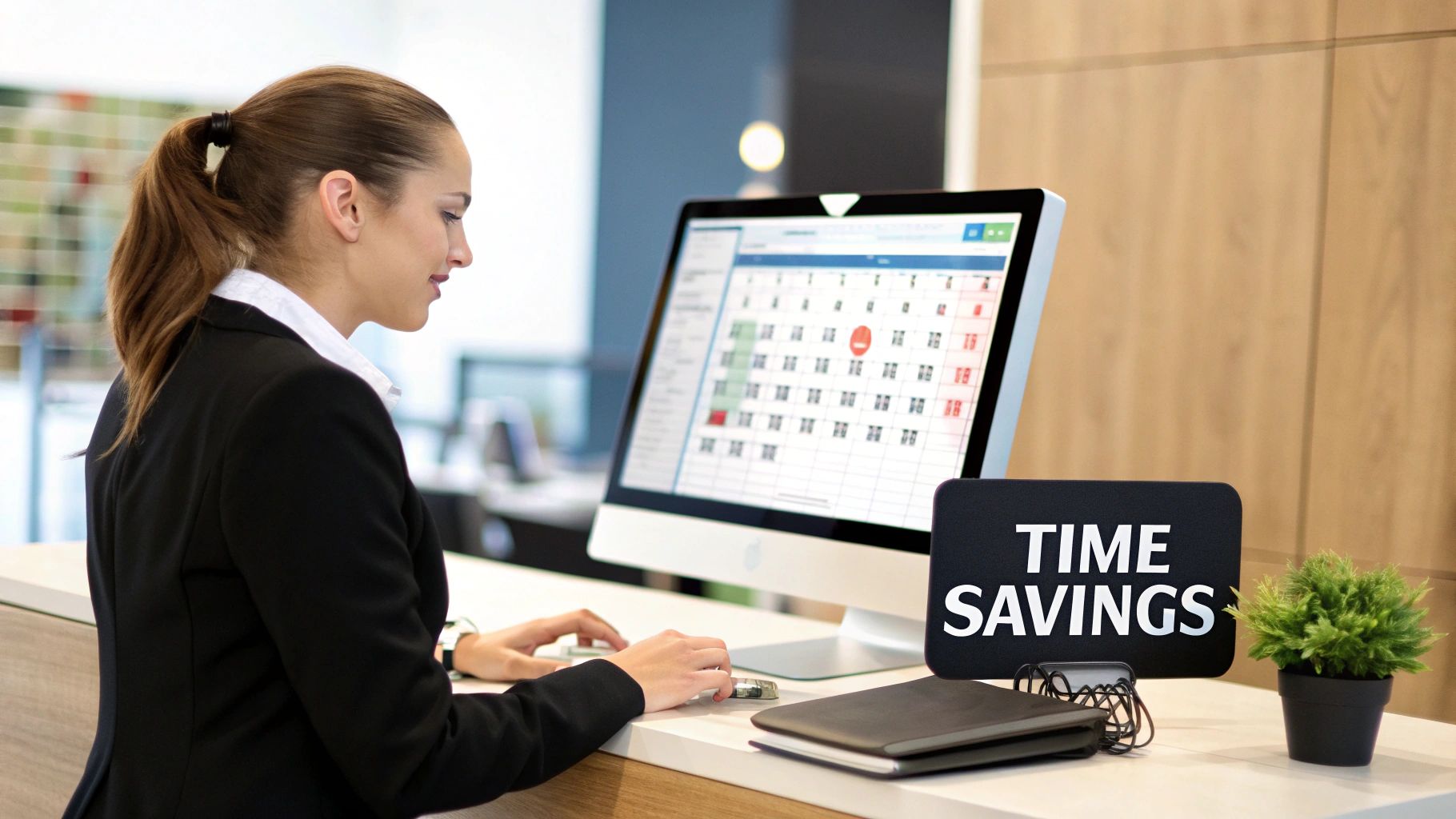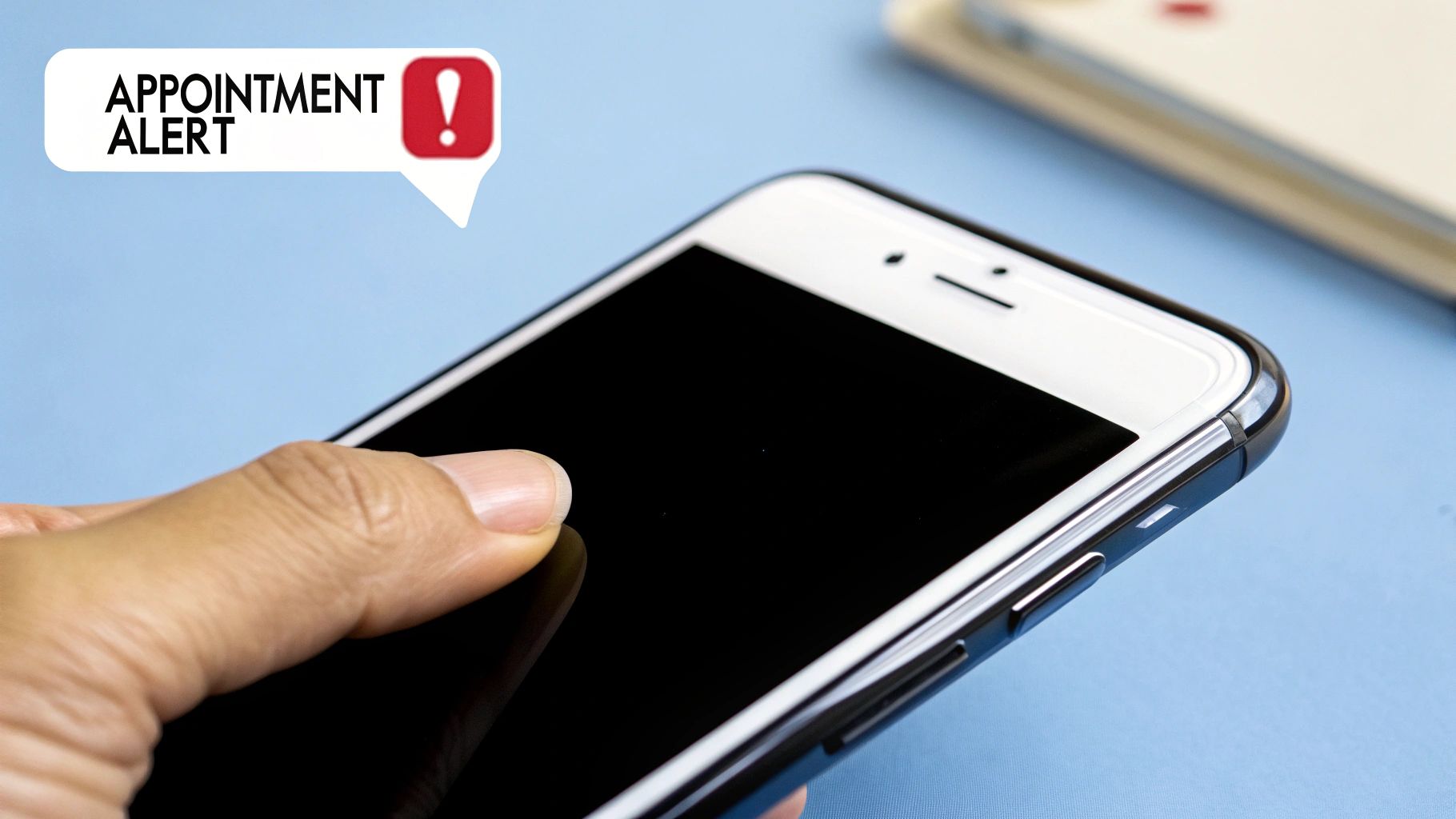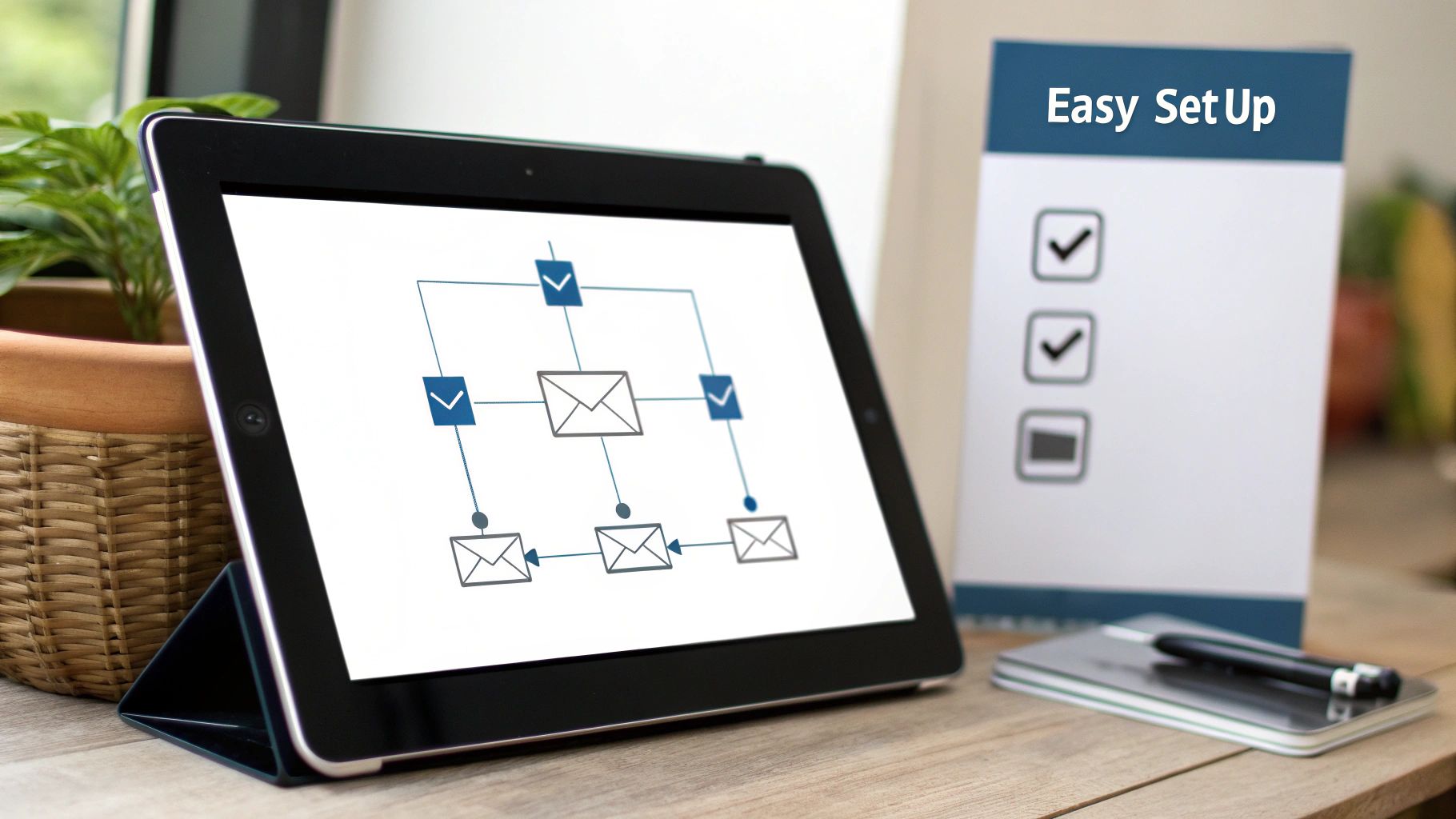Automated appointment reminders are exactly what they sound like: messages sent automatically by SMS, email, or even a voice call to confirm a client's upcoming booking. But they're much more than just a notification. Think of them as a friendly, professional nudge that helps prevent no-shows, keeps your schedule packed, and turns tentative appointments into guaranteed revenue.
Unlock Efficiency and Slash No-Shows
Imagine your daily schedule running like a finely tuned machine. Every client shows up on time, prepared and ready to go. This isn't a fantasy; it's what automated appointment reminders can deliver. It's best to see them not just as a piece of software, but as a tireless digital assistant working around the clock to stop costly no-shows and last-minute cancellations before they happen.
These systems automatically send out perfectly timed messages to confirm upcoming appointments, acting as a powerful tool to keep your business at the front of your clients' minds. That simple, automated ping is often the final key that locks in a booking, making it a reliable source of income for your business.
How Reminders Really Work
At its core, an automated reminder system closes the gap between the moment a client books an appointment and the moment they need to walk through your door. Life gets busy, and it's incredibly easy for people to forget commitments they made weeks or even just a few days ago.
A well-timed reminder is more than just a notification; it's a helpful service for your client that simultaneously protects your most valuable asset: your time. This simple, proactive step dramatically cuts down on the hours your team would otherwise spend making manual follow-up calls, freeing them up to focus on what they do best.
The explosive growth in this technology proves just how critical it is. The market for appointment reminder software is on track to hit USD 128.5 million by 2028. What's driving this? A clear need to reduce missed appointments. Studies have shown that when reminders are sent via SMS, less than 5% of appointments are missed. For a deeper look, you can explore more appointment reminder statistics to see the full impact.
This infographic breaks down the direct benefits businesses experience, from a massive drop in no-shows to significant time savings and a fantastic return on investment.

The data doesn't lie. Putting these systems in place delivers real, measurable results in efficiency, client retention, and your bottom line.
Manual vs. Automated Reminders At a Glance
To really appreciate the difference, it helps to see the old way next to the new way. The contrast between tying up your staff with phone calls and letting a system handle it is stark.
Aspect Manual Reminders (Phone Calls/Emails) Automated Reminders (SMS/Email/Voice) Time Investment High; requires dedicated staff hours daily Minimal; set it up once and it runs itself Scalability Poor; difficult to manage with a growing client base Excellent; handles hundreds of reminders effortlessly Consistency Prone to human error, forgotten calls, and typos 100% consistent; messages are sent on schedule every time Client Convenience Can be intrusive (phone calls) or missed (emails) Highly convenient; SMS is immediate and has a 98% open rate Cost High labor costs for staff time Low monthly subscription fee; high ROI Tracking & Reporting Difficult; no easy way to track confirmations or delivery Simple; provides clear data on delivery, opens, and responses Ultimately, while manual reminders come from a good place, they simply can't compete with the efficiency, reliability, and professionalism of an automated system. The switch frees up your team and provides a better, less intrusive experience for your clients.
The Real Business Impact of Automation

Let's get straight to the point. Moving to automated appointment reminders isn't just a small-time convenience—it’s a powerful business move with a very real and measurable payoff. The most immediate win? Slashing your no-show rates and recovering revenue that would have otherwise vanished into thin air.
Think about it. Every missed appointment is a hole in your bottom line. By making sure clients get a timely, professional nudge, you're not just saving money; you're actively protecting the income you've already worked to secure. You start plugging those revenue leaks, creating a far more reliable and predictable cash flow.
Give Your Team Their Time Back
Beyond the hard numbers, there’s the human side of the equation. Manually calling to confirm appointments is a tedious, soul-crushing task that saps your team's energy and focus. Automating this frees them from hours of playing phone tag and drowning in administrative busywork.
With that time back, your staff can finally concentrate on what they do best: high-value activities that actually grow the business. Instead of leaving yet another voicemail, they can deliver amazing service to the customer standing right in front of them, solve complex problems, or follow up on new leads. It’s a simple trade—swapping low-impact repetition for high-impact engagement.
The real magic of automation isn’t just doing old tasks faster. It’s about empowering your team to take on entirely new, more valuable work they simply didn't have time for before.
This shift does wonders for more than just the daily to-do list. It boosts job satisfaction. When people feel like their work matters, morale goes up, and they stick around longer. You end up with a stronger, happier, and more effective team.
Elevate the Customer Experience
A professional touch goes a long way. Automated reminders deliver a consistent, polished message that makes your business look good. Customers don't see it as a nuisance; they see it as a helpful service. You’re showing them you’re organized and that you respect their time.
This simple act of communication builds trust and reinforces their decision to work with you. It’s a subtle but powerful way to provide a smooth experience from the moment they book to the second they walk through your door. That positive feeling is what builds long-term loyalty and keeps people coming back.
- Look professional: Every client gets the same high-quality, branded message, every time.
- Be convenient: Reminders land on their phone via SMS, where they’re easy to see and act on.
- Be reliable: Customers learn to count on getting a reminder, which helps them stay organized, too.
This is especially critical in fields like healthcare, where no-shows don't just hurt the bottom line—they disrupt patient care. In some practices, missed appointment rates can climb as high as 30%. When you pair automated reminders with a solid scheduling platform, the results get even better. You can dive deeper into the powerful benefits of an online booking system to see how these tools work together.
Essential Features of Reminder Software

When you start shopping for an automated reminder system, the sheer number of options can feel like a lot to sort through. But here's the secret: it's not about finding the software with the longest feature list. It's about finding the one with the right features that will actually make a difference for your business.
Let’s cut through the noise and talk about what really matters. Think of these as the non-negotiables.
The absolute foundation of any good system is multi-channel delivery. This simply means the software can send reminders through different channels—like SMS, email, and sometimes even automated voice calls. People have their preferences, right? Some live in their email inbox, while others only glance at texts. A system that can reach your clients where they are is always going to get better results.
Moving Beyond Simple Alerts with Two-Way Communication
Now, this is where things get really interesting. One of the biggest game-changers is two-way communication. Instead of just blasting a one-way message into the void, this feature turns a reminder into a real conversation.
Imagine your client gets a text and can simply reply "C" to confirm or "R" to reschedule. That single action can instantly update your calendar, freeing up your team from hours of manual phone calls and follow-ups. It's an incredibly simple and low-friction way for clients to manage their appointments, which makes your schedule far more accurate and reliable.
This kind of efficiency is a huge reason the appointment reminder software market is growing. It’s also why we’re seeing such a massive shift to mobile. With 82% of customers now preferring to schedule on their phones, SMS and mobile-friendly features aren't just nice-to-haves; they're essential. You can dig deeper into the key drivers of the appointment software market to see how cloud-based tools are making this technology more accessible than ever.
Customization, Smart Timing, and Key Features
Your brand has its own voice, and your automated messages should too. That's why customizable message templates are a must. A solid platform will let you easily edit the wording, add your business name, and drop in personal details like the client’s first name or the specific service they booked. This small touch transforms a robotic alert into a professional, on-brand communication.
A well-crafted, automated message does more than just remind; it reinforces your brand's professionalism and commitment to a positive client experience.
Finally, you need smart scheduling. This isn't just about sending one reminder—it's about sending the right message at the right time. The best systems let you build a sequence, or "drip," of reminders. A great workflow might look something like this:
- Immediate Confirmation: An email confirmation goes out the moment the appointment is booked.
- 48-Hour Heads-Up: A more detailed email reminder is sent two days before.
- Day-Of Nudge: A quick SMS reminder is sent 2 hours before the appointment.
This strategic cadence covers all the bases, ensuring your client is well-informed without feeling spammed.
To help you decide what's critical versus what's just extra, here's a quick breakdown of common features.
Essential vs Advanced Reminder System Features
This table can help you prioritize what to look for when evaluating different tools, whether you're just starting out or looking to upgrade your current system.
Feature Category Essential (Must-Have) Advanced (Nice-to-Have) Messaging SMS and Email delivery Voice call reminders, WhatsApp integration Interactivity Two-way communication (e.g., confirm/cancel via text) Automated rescheduling links Customization Editable message templates with personalization tags Fully customizable HTML templates for emails Scheduling Flexible timing and reminder sequences "Smart" timing based on client history Integration Syncs with your primary calendar (Google, Outlook, etc.) Full integration with CRM or EMR/EHR systems Reporting Basic delivery and confirmation reports In-depth analytics on no-show rates and client engagement Ultimately, choosing a system with the right core features—multi-channel options, two-way texting, customization, and smart sequencing—is what will protect your time, reduce no-shows, and keep your schedule running smoothly.
How to Set Up Reminders for Maximum Impact

Having the right software is just the first step. The real magic happens when you implement it thoughtfully. Getting your automated appointment reminders set up correctly from the get-go is what turns a neat tool into a no-show prevention powerhouse.
It’s all about striking the perfect balance between timing, frequency, and the message itself. Think of yourself as a helpful guide for your client. Your job is to give them clear, timely information that helps them remember their commitment without ever feeling pushy. The goal is to make showing up the easiest, most natural thing for them to do.
Perfecting Your Timing and Frequency
So, how many reminders are too many? And how few is not enough? It's the most common question I hear. If you send too few, you risk being forgotten. Send too many, and you’ll just annoy them. From what I’ve seen work for countless service businesses, a multi-step approach is the sweet spot.
A proven strategy follows the client’s own mental timeline, giving them just the right information at just the right time. Here’s a workflow that works wonders:
- The Initial Confirmation (Immediately): As soon as they book, an email should hit their inbox. This message is their digital receipt; it locks in the details while the appointment is still fresh in their mind.
- The 24-48 Hour Heads-Up (Email or SMS): This is your most critical reminder. Sending it one or two days ahead of time gives clients a real chance to reschedule if a conflict popped up. This single step protects you from those frustrating last-minute gaps in your calendar.
- The Day-Of Nudge (SMS): A quick, friendly text message sent 2-4 hours before the appointment is the final nudge. It brings the appointment right to the front of their mind as they're planning their immediate schedule.
This simple sequence ensures your message gets through without ever feeling like spam.
Crafting the Perfect Reminder Message
Clarity is everything. Your message needs to deliver the essential info in a way that someone can grasp in three seconds flat, especially on a text message.
Whether it’s an email or an SMS, every reminder absolutely must include:
- Client's Name: A little personalization makes a big difference.
- Business Name: Make it obvious who you are.
- Appointment Details: The non-negotiable date and time.
- Location: Your physical address or a direct link for a virtual call.
- Clear Call-to-Action: Give them a simple way to respond, like "Reply YES to confirm."
A great reminder is more than just a blast of information; it's the start of a conversation. When you enable two-way communication, you empower clients to manage their own schedules easily, which is the key to reducing friction and no-shows.
Setting up these reminders is a cornerstone of professional scheduling. If you're ready to take the next step, our guide on how to maximize efficiency with professional appointment booking dives into more strategies that build on this foundation. It’s all about creating a seamless process from the moment they book to the moment they walk through your door.
Writing Reminder Messages That Get a Response
Let's be honest: the best reminder software on the planet is just expensive noise if your messages get ignored. A great reminder message confirms appointments and protects your revenue. A bad one is just more digital static for your clients to swipe away.
The real secret to writing automated reminders that actually work comes down to a simple formula: Clarity + Brevity + Personality. Your entire goal is to give a busy client all the information they need in the three seconds they'll spend glancing at their phone. This is especially true for text messages, where attention is fleeting.
Keep It Clear and Concise
When that reminder pops up on your client's screen, there should be zero confusion about who it's from or what it's for. Long, winding messages are the enemy—they get skipped over immediately. You have to get straight to the point.
Every single message must include these essentials:
- Your Business Name: Don't make them play a guessing game.
- The Client's Name: A touch of personalization goes a long way. It shows you know who they are.
- Appointment Details: The exact date and time are absolutely non-negotiable.
- A Simple Action: Tell them precisely what you want them to do next. Think "Reply C to confirm."
Imagine your reminder is a road sign. It needs to give clear, simple directions at a glance. Anything else is just a distraction that makes it less likely they'll do what you need them to do.
Personalize and Inject Your Brand Voice
Just because the message is automated doesn't mean it has to sound like a robot sent it. This is a fantastic, low-effort opportunity to show off a bit of your brand's personality and strengthen your connection with your clients.
A friendly, personalized reminder feels less like a cold system notification and more like a helpful nudge from a business that actually cares. This small touch is what separates a good reminder system from a great one.
So, ditch the dry, default templates. A wellness clinic might go for something warm and inviting, like, "Hi [Name], we're so looking forward to seeing you!" A formal financial advisory firm, on the other hand, might stick with something more reserved, such as, "Dear [Name], this is a courtesy reminder for your upcoming consultation."
Here’s a look at how this plays out in a couple of real-world examples:
Good SMS Template (Friendly & Casual) Hi [Client Name]! Just a friendly reminder about your appointment with [Business Name] tomorrow, [Date], at [Time]. Please reply YES to confirm or call us to reschedule. See you soon!
Better SMS Template (Professional & Action-Oriented) Reminder: Your appointment with [Business Name] is scheduled for [Date] at [Time]. To confirm your spot, please reply C. To reschedule, please call our office at [Phone Number].
Notice how the second example is a bit more direct? It pushes for a simple, one-letter response, which we've found often boosts confirmation rates because it's just so easy to do. The key is finding a voice that feels authentic to your business while making the message impossible to misunderstand.
How to Choose the Right Reminder Software
Picking the right software for your automated appointment reminders can feel a bit like wading through a sea of options. The trick is to find a tool that actually fits how you work.
Think of it like buying a new pair of work boots. A construction worker and a chef both need sturdy footwear, but their specific needs are worlds apart. Your business is no different—you need a solution that’s built for your specific challenges and clientele, not a one-size-fits-all product.
The first thing to look for is ease of use. Seriously. If the software is a pain to navigate, your team will find every excuse not to use it, and your investment goes right out the window. A clean, intuitive dashboard where you can set up reminders without pulling your hair out is a must. Take advantage of free trials to get a real feel for the platform before you commit.
Next up, integrations. Your reminder tool needs to play nice with the software you already depend on every day, especially your calendar. If it doesn’t sync flawlessly with your Google Calendar, Outlook, or Apple Calendar, you’re just creating a new set of problems. Poor integration is a recipe for double bookings and chaos.
Evaluating Core Functionality and Support
Beyond the basics, you have to dig into whether a platform can handle your specific, day-to-day needs. Different fields have different requirements, after all. A dental office has different scheduling challenges than a law firm. Our guide on tailored scheduling solutions for every industry dives into this, which can help you pinpoint the features that really matter for your business.
As you start comparing different tools, keep a simple checklist of questions handy to ask during demos or while you're on a trial run:
- Customization: Can I change the message templates to sound like my brand, not a robot?
- Two-Way Communication: Can clients simply reply "YES" to confirm or "NO" to cancel, right from the message?
- Scalability: Is this a tool that can grow with my business, or am I going to outgrow it in a year?
- Support: When something goes wrong (and it will), what kind of help can I expect to get?
Remember, solid customer support and clear, upfront pricing are just as vital as the features themselves. Nothing sours a new tool faster than surprise fees or a support team that’s impossible to reach.
Last but certainly not least, lock down data security. If you handle any kind of sensitive client information—especially in fields like healthcare, finance, or legal services—you absolutely must ensure the provider meets security standards like HIPAA or GDPR. Your clients are trusting you with their personal data. Your choice in software needs to honor that trust.
By focusing on these key areas, you can cut through the noise and find a solution that genuinely saves you time, slashes your no-show rate, and feels like a natural extension of your workflow.
Your Questions, Answered
Even when the benefits are crystal clear, bringing a new tool into your workflow naturally raises a few questions. Let's walk through some of the most common ones we hear about setting up and getting the most out of automated appointment reminders.
How Many Reminders Should I Send?
This is probably the most-asked question, and for good reason. You want to be helpful, not annoying. For most businesses, the magic number is two reminders. This gives you a couple of chances to connect without overwhelming your client's inbox or phone.
Here’s a common, effective timeline:
- The First Nudge (24-72 hours before): This is your main reminder. Sending an email or text a day or two ahead gives clients plenty of time to remember the appointment and, crucially, to reschedule if something has come up. This is your best defense against those frustrating last-minute cancellations.
- The Day-Of Ping (1-4 hours before): Think of this as a final, friendly tap on the shoulder. A quick SMS message on the day of the appointment brings it to the front of their mind right when they need to start thinking about it.
Are SMS or Email Reminders More Effective?
If you're looking for sheer "did they see it?" power, SMS is the undisputed champ. Text messages have incredible open rates, often hitting 98% or more. For urgent, can't-miss messages, nothing beats a text.
But the real answer isn't about picking one over the other—it's about using them together. An initial email is perfect for laying out all the details (like directions or prep instructions), while a final text delivers that quick, unmissable confirmation prompt.
The best approach? Let your clients choose. Giving them the option to pick how they receive alerts shows you respect their preferences.
The smartest reminder systems communicate with clients on their own terms. SMS delivers speed, while email provides detail. Using both—and letting clients choose—is the gold standard for a great customer experience.
What Information Is Absolutely Essential?
Keep it clear and simple. Your client should be able to understand the entire message in a five-second glance. No matter what, make sure every reminder includes these six things:
- The client’s first name (personalization matters!)
- Your business name
- The specific service they booked
- The full date and time of the appointment
- Your address or a link for virtual meetings
- A clear, simple way to respond (e.g., “Reply YES to confirm”)
Will Automated Reminders Feel Impersonal?
Only if you let them. It's a common fear, but modern reminder software is built for personalization. Simply using the client's name, mentioning their specific service, and tweaking the message to match your brand's voice goes a long way.
Most clients don't see these as robotic intrusions. They see them as a genuinely helpful service that saves them from a "whoops, I forgot!" moment. It shows you're organized and that you value their time—and yours.
Ready to put no-shows in the rearview mirror and win back precious time for your team? Novacal makes it incredibly easy to set up professional, personalized reminders that just work.

